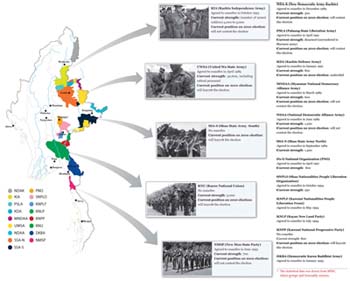To Fight or Not to Fight
As the 2010 election approaches, Burma’s ethnic armies are becoming restless
OVER the past decade, a patchwork of ceasefire agreements, if not actual peace, has reigned over most of Burma’s ethnic hinterland. Of the many ethnic insurgent armies that once battled the Burmese regime, only a handful are still waging active military campaigns. The rest remain armed, but have shown little appetite for renewed fighting—so far.
With an election planned for sometime next year, however, the status quo is looking increasingly unsustainable. The junta is pushing its erstwhile adversaries to form parties and field candidates, and while some have unenthusiastically complied, others have begun to chafe at the persistent pressure.
The Wa, on the other hand, have been more openly resistant to the regime’s plans to use the election to end hostilities permanently.
The United Wa State Army, with 20,000 troops under its command, was formed 20 years ago out of the ashes of the Burman-dominated Communist Party of Burma. Soon after, it signed a ceasefire deal with then-intelligence chief Gen Khin Nyunt, who was ousted in 2004. Since then, relations with the Burmese junta have been strained.
Recently, these tensions have intensified, raising concerns that the Wa are preparing to go back on the warpath. However, Chinese officials from Yunnan Province, which borders the Wa territory, say they are working to calm rising tempers on both sides.
The situation farther south is similarly varied, depending on the ethnic army in question.
The Shan State Army-South, a non-ceasefire group, spoke out against the election at a ceremony marking the Shan national day in February. Its position is unlikely to change, despite talk of Thailand intervening on the Burmese junta’s behalf, because the group acts as a buffer between Thailand and the drug-trafficking Wa.
The Karen National Union, which has the largest army still fighting the regime, has also denounced the election as a sham. But the group is increasingly fragmented and under growing pressure from Thailand to end its more than six decades of armed struggle.
Mon rebels, who also rely on Thailand for supplies and logistical support, entered a ceasefire agreement with the regime in 1996. They have kept their distance from the election, but are closely monitoring developments in central Burma.
Although no clear picture has emerged of what the election will mean for Burma’s disparate ethnic armies, the junta’s ambitious plans to redraw the country’s political map seem as likely to stir up old resentments as they are to usher in an unprecedented era of stability in frontier areas.
|
||
|
||
|
||
|
||
|
||
|
||


